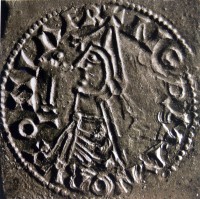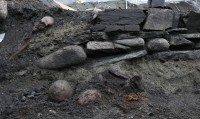 Archaeologists with the Norwegian Institute for Cultural Heritage Research (NIKU) have discovered the foundations of the church where the Viking king Olaf II is believed to have been buried after he was canonised. King Olaf II Haraldsson, credited with introducing Christian law to Norway, was killed in nebulous circumstances in 1030. The earliest chroniclers reported that he was assassinated either by his own men or in an ambush, but later accounts give him a more glorious death at the Battle of Stiklestad on July 29th, 1030.
Archaeologists with the Norwegian Institute for Cultural Heritage Research (NIKU) have discovered the foundations of the church where the Viking king Olaf II is believed to have been buried after he was canonised. King Olaf II Haraldsson, credited with introducing Christian law to Norway, was killed in nebulous circumstances in 1030. The earliest chroniclers reported that he was assassinated either by his own men or in an ambush, but later accounts give him a more glorious death at the Battle of Stiklestad on July 29th, 1030.
He was buried in Nidaros (modern-day Trondheim) and very quickly stories sprang up of miraculous occurrences at his grave site. A year after his death, Bishop Grimkell, one of several English missionary bishops reputedly brought to Norway by Olaf, exhumed his body and found it miraculously uncorrupted. Grinkell declared Olaf a saint and his body was translated to a place of honor above the high altar of St. Clement’s church, a wood stave church Olaf had built a few years before his death. The local canonisation was confirmed by Pope Alexander III in 1164 and Olaf became an official Roman Catholic saint.
Olaf’s body was moved again some decades later to Nidaros Cathedral, a larger and more glamorous site that could accommodate the increasing number of pilgrims dedicated to the cult of Saint Olaf. Over time, St. Clement’s was destroyed and its location forgotten.
 Now it seems it has been rediscovered during an excavation on Søndre gate street in Trondheim. The Norwegian Institute for Cultural Heritage Research team discovered the stone foundations of a wooden stave church. Preliminary dating indicates the structure was built in the 11th century.
Now it seems it has been rediscovered during an excavation on Søndre gate street in Trondheim. The Norwegian Institute for Cultural Heritage Research team discovered the stone foundations of a wooden stave church. Preliminary dating indicates the structure was built in the 11th century.
During its excavation, the archaeologists uncovered a small rectangular stone-built platform at the building’s east end. This is probably the foundation for an altar – probably the very same altar on which St. Olaf’s coffin was placed in 1031! In addition, a small well has been found here which may be a holy well connected with the saint.
In the words of the excavation’s director Anna Petersén:
“This is a unique site in Norwegian history in terms of religion, culture and politics. Much of the Norwegian national identity has been established on the cult of sainthood surrounding St. Olaf, and it was here it all began!”
NIKU has created a series very cool 3D models illustrating the progress of the excavation.
The Søndre gate excavation site 10/01/2016:
The Søndre gate excavation site 10/19/2016, the choir begins to take shape:
The Søndre gate excavation site 10/29/2016:
The remains of the church:
thanks for the marvelous posting! I seriously enjoyed reading it, you happen to be a great author.I will remember to bookmark your blog and will come back in the future. I want to encourage yourself to continue your great posts, have a nice day!
I believe Rose Nylund would really enjoy today’s post, just as I have. Thank you.